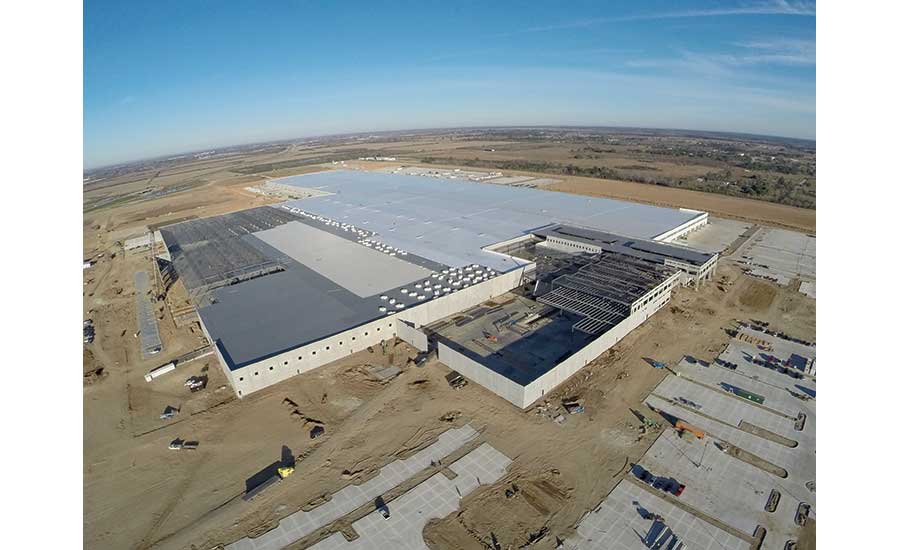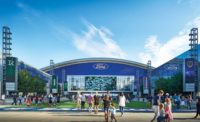A massive manufacturing campus is rising in Waller, Texas, about 40 miles northeast of Houston off U.S. 290 and three miles west of State Highway 99. Daikin Industries Ltd., Osaka, Japan, is concurrently expanding, consolidating and relocating the manufacturing and logistics of its Goodman subsidiary to the new campus.
A strategic design-build delivery and preconstruction planning ahead of each phase have been crucial in building the campus, especially when the project required erecting tilt-up wall panels around the entire building and accommodating a “no interior walls” design concept, all while adapting the tight schedule to weather delays.
The facility will bring together operations previously spread across sites in Texas and Tennessee, combining in one location engineering, quality control, distribution, administration, a research and development center, logistics, procurement, manufacturing and marketing. The majority of products manufactured at the new facility will be residential and commercial heating and cooling systems.
“The entire facility represents one of the largest investments made by Daikin Industries and demonstrates the company goal to produce products in the country where the products are sold and installed,” says Takeshi Ebisu, president and CEO of Daikin.
Planning began in January 2015 when Daikin committed $417 million to the Daikin HVAC Equipment Engineering, Manufacturing and Logistics Campus, or what is now being called the Daikin Texas Technology Park.
Daikin’s team determined that a greenfield site was the best option to meet the criteria for the campus, which would also allow for future expansion, explains Michelle Jack, director of projects at Daikin. Waller’s plentitude of undeveloped land, proximity to two major highways and the fact that it’s not in a floodplain make it ideal, she says.
“It was also selected because a majority of the current employee population calls the general vicinity of Waller home,” notes Kari Durham, senior vice president of human resources for Daikin.
Phased, Fast-Track Delivery
Bringing all of Goodman’s facilities under one roof required a large site; the final building spans 4.2 million sq ft and includes a 1.8-million-sq-ft distribution center, a 214,000-sq-ft administrative and lab area, plus an expansive new manufacturing space—though the company is not releasing the exact square footage for that section for competitive reasons.
Contractor D.E. Harvey Builders, along with Daikin’s senior staff, broke ground in March 2015. Work is being done in three phases: a distribution center, administrative-lab space and the manufacturing area.
“This project is unique in both the magnitude and strategy for delivery,” explains David Brown, senior project manager at D.E. Harvey. “This project is considered the largest tilt-wall building in the world and potentially the largest single building in Houston.”
The tilt-wall panels themselves extend 2.3 miles around the site. To handle the massive amount of concrete required on the job—300,000 cu yd—five concrete providers were hired, each one working on a specific section of the building, Jack explains. For eight months in 2015, teams placed an average of 1,800 cu yd of concrete per day. The entire project has about 5 million sq ft of site paving.
Each of the tilt-wall panels was cast on site, with the majority of them weighing 75,000 lb each; the largest panel weighs 207,000 lb.
In order to meet the speed and phased approach Daikin required on the project, a fast-track, design-build, rolling guaranteed maximum price delivery strategy was key, Brown adds.
“As fast as the customer end-user groups finalize their space and use programs, the phase elements are bought and executed,” he says.
“This project is considered the largest tilt-wall building in the world and potentially the largest single building in Houston.”
—David Brown, Senior Project Manager,
D.E. Harvey Builders
The owner occupied the first portion of the distribution center in early February, while the last wall was being raised in the manufacturing section, Jack notes.
“Additionally, we will be installing product assembly and lab-testing equipment during construction to reduce the time needed to have an operating facility,” Jack says.
The hand-in-glove overlap of OEM (original equipment manufacturer) selection and procurement with building design and construction has been another challenge, Brown notes. “The design and construction of the project has evolved, in real time, as OEM systems and machinery procurement have been finalized. MEP and structural systems are tweaked and finalized just in time to support OEM deliveries,” he explains.
Extensive preconstruction planning made the accelerated schedule possible. Teams collaborated for about six months before work began, Brown explains. “Even now, 18 months into construction, with Phase 1 complete, and Phase 2 60% complete, we are still engaged in preconstruction planning for the final phase,” he says.
Significant rainfall across the Houston area over the last 18 months has led to construction delays. Brown notes that teams have worked through both 100-year and 500-year rainfall. “Earthwork, concrete and roofing trades, in order to ameliorate the time impact of this weather, have essentially worked in schedule-recovery mode for the entire duration of their scope,” he says.
Open Space
Another design feature of the building is the lack of interior walls, requiring the use of stronger beams and large piers to support them and a rainwater drainage system that can divert water from a roof that spans almost 100 acres, Jack explains.
Steel rafters support the roof itself, while a waterproof membrane has been laid over the insulating tiles.
“Ours is among the largest contiguous roofing surfaces ever built. It’s a TPO [thermoplastic polyolefin] roofing system, with a combination of perimeter roof gutters and interior piped roof drains,” says Brown. “The perimeter roof drains were utilized for economy, and the interior piped drains were required by the area of roof.”
Brown adds that the roof was designed according to both roof design and civil engineering standards. “Because our roof area is so great, it is required to drain in a manner similar to a parking lot,” he says. “So far, our roof has performed exceptionally well through two 100-year rain events and one 500-year rain event.”
An onsite sanitary wastewater treatment system flows its effluent into an earthen holding tank, which is a partial source for the site irrigation system, Brown explains.
However, roof drainage doesn’t flow into the holding tank, but rather into a 43-acre site retention-detention pond, he says. “The site pond not only satisfies the flood control requirements, but is also an attractive amenity with over 5 feet of freeboard volume to accommodate the decorative lake feature,” Brown says. “Since we expanded an existing pond to create our detention-retention feature, it is pre-stocked with perch, bass and catfish.”
More than 700 workers were on site at peak construction, and as of March, project teams have worked about 500,000 man-hours. “In order to avoid overloading the manpower resources of any one contractor, multiple contractors in each trade were awarded different phases of the project,” Brown says.
The campus is scheduled to be complete by early September, Brown says, and Daikin has tentatively scheduled manufacturing to start in early October.
When fully operational, the campus will employ up to 5,000 people.




